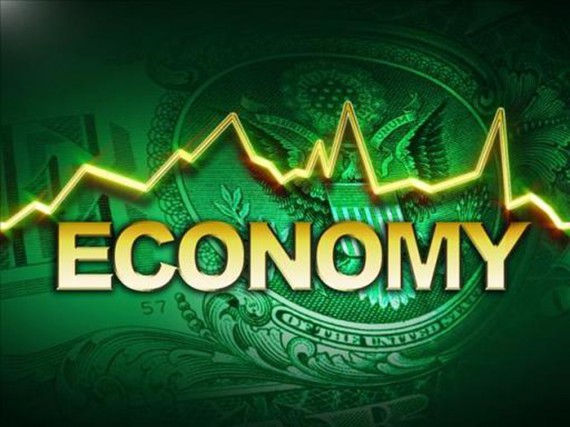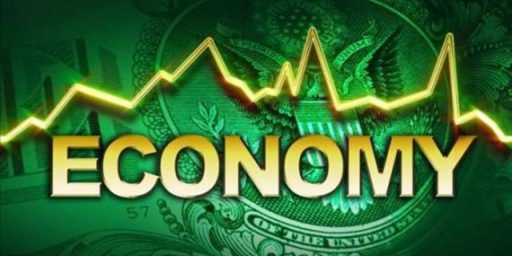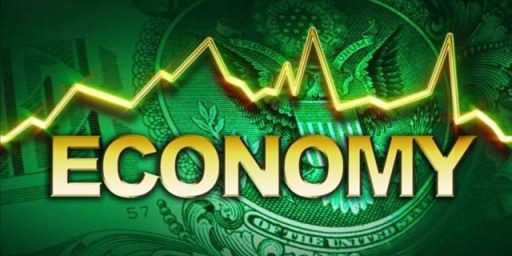Economic Growth Over The Summer Was Quite Sluggish
Gross Domestic Product grew at a sluggish 1.5% in the just-concluded Third Quarter, calling the Federal Reserve's apparent plan to raise interest rates at some point even further into question.
The first estimate of Gross Domestic Product growth for the quarter that ended September 30th shows that the economy grew at a relatively anemic rate, which in part explains why the Federal Reserve Board has held back on raising interest rates:
Despite still-healthy spending by consumers, the American economy slowed significantly last quarter, the government said Thursday.
At an annualized rate of 1.5 percent, which was in line with analysts’ expectations, the tempo of growth in July, August and September represents a marked drop from the 3.9 percent pace of expansion in the spring.
But the downshift last quarter was mostly caused by slower inventory accumulation, as businesses let stockpiles of goods in warehouses and on store shelves unwind rather than making big additions, as they had done in the first half of 2015. Nonfarm inventories increased at half the rate they did in the second quarter, a reduction that shaved 1.44 percentage points off the overall figure for growth in the third quarter.
While the headline rate was lackluster, major components of the economy, including consumer demand and business spending on equipment, held up well in recent months. Consumption rose 3.2 percent last quarter, compared with a 3.6 percent advance in the spring.
Residential investment also remained healthy last quarter, a sign that the housing market, after a long period of suffering, is now providing the overall economy with a fresh tailwind.
Stocks opened slightly lower, but bond yields ticked up, a sign traders are increasingly looking at the possibility of a rate increase by the Federal Reserve in December following the central bank’s decision to hold off on an increase on Wednesday.
“Outside of the inventory correction, this was a solid report,” said Scott Anderson, chief economist at Bank of the West in San Francisco. “It bolsters the case that we will see a bounce-back in growth,” he added, noting that his firm is looking a growth rate in the current quarter of about 2.5 percent.
In terms of the drag from stockpiles, “companies scaled back their expectations,” Mr. Anderson said, so the drop-off in inventories “should diminish as a headwind.”
In a separate report from the Labor Department on Thursday, the government reported that new claims for unemployment benefits rose by 1,000 to 260,000 last week, less than expected. The four-week moving average for jobless claims, which can be more reliable than the week-to-week snapshot, fell to its lowest level since 1973 and suggested that hiring remained fairly strong.
The pluses and minuses buried in the fine print of Thursday’s reports on economic output and hiring highlight the contradictions that economists, Federal Reserve policy makers and ordinary consumers all have to contend with after more than six years of tepid economic growth.
Some sectors — technology, health care, finance — are enjoying conditions that echo the booming 1990s or the housing bubble a decade ago.
Things could not be more different in areas of the economy that depend on commodity prices, like the oil and gas industry, which is cutting jobs amid a downturn in energy prices. Manufacturers that service those industries, like steel makers, have also felt a chill.
Echoing this pattern, economic conditions are best on the coasts, especially the Northeast as well as Silicon Valley, while broad swaths of the country’s midsection struggle.
“We’ve got a lot of folks moving into the Bay Area getting jobs, and you see the growing pains that come with that, like traffic and housing affordability,” said Mr. Anderson. “The incubator is the tech sector, but it’s broader-based than that.”
At the same time, he said, “the decline in energy and commodities is having a detrimental effect on growth from Texas north to Minnesota.”
Thursday’s report is the first of three estimates the government will make and the numbers could be revised upward or downward as more data comes in.
While investors have generally been pleased with the moderate pace of growth in recent years, even as many workers complain about stagnant wages, Fed officials are still trying to determine when economic conditions will finally justify a long-anticipated increase in interest rates.
Marketwatch’s assessment is somewhat more negative, and not exactly positive for the fourth quarter either:
WASHINGTON (MarketWatch) — The U.S. economy cooled off in the third quarter as companies cut back production to prevent a worrisome buildup in inventories, particularly of goods destined for foreign markets.
Gross domestic product — the value of everything a nation produces — rose at a 1.5% annual pace from July through September, the government said Thursday. The U.S. had grown at a crisp 3.9% rate in the second quarter.
The slowdown stemmed mostly from the biggest drawndown in inventories in three years. Companies also cut spending on structures such as oil platforms and commercial buildings.
Yet even as businesses showed more caution, consumers continued to spend money at steady clip, a sign they are not as worried. Consumer spending, the single largest determinant of U.S economic growth, rose at a 3.2% annual pace following an even larger gain in the second quarter.More confident than at any time since the end of the recession in 2009, consumers have spent heavily on new cars and trucks. Outlays on so-called durable or long-lasting goods climbed 6.7% in the third quarter.
What’s fueled the upturn in spending are higher inflation-adjusted incomes, a residue of cheap gas. Millions of Americans have also found jobs over the past several years, giving them more money to spend.
Economists predict consumer spending will show another healthy gain in the final three months of 2015, potentially pushing GDP back toward the 2.5% range or higher.
“Although the headline number of 1.5% growth was a big weaker than expected, the details were quite good, said Stuart Hoffman, chief economist of PNC Financial Services.
Still, the third-quarter dropoff almost assures the U.S. will fail to break 3% annual growth in 2015 for the 10th straight year. The last time the economy expanded that fast was in 2005.
More skittish behavior by businesses is the chief reason. U.S. companies such as manufacturers with lots of foreign customers were hit hard during the summer by a dollar whose surging value raised the price of American-made products.
At the same time, U.S. energy companies cut spending on rigs, heavy machinery and other expensive equipment after the slump in oil prices.
Worried about an inventory overhang, businesses trimmed production. The value of inventories rose just $56.8 billion from July to September after $100 billion-plus increases in the prior two quarters that marked the biggest back-to-back gains ever
This report came the day after the Federal Reserve announced yet again that it would withhold on raising interest rates for a second month in a row after having announced in September that a much-anticipated rise in lending rates that have been at or near zero since the Great Recession started would not happen immediately. That announcement came after a summer which saw a falling stock market in China that had a worldwide impact that lasted into August. The fact that signs were appearing that one of the world’s fastest growing economies could be slowing down significantly. was obviously a cause for concern, but the fact that it was starting to have an impact around the world suggested that raising interest rates while those factors were still playing out may not be a good idea. Closer to home, the American economy, which had actually shrunk slightly in the first quarter of the year,rebounded slightly in the second quarter but still showed signs of weakness. At the same time, the job market seemed to be losing the momentum it had earlier in the year, which some analysts suggested could be tied to the domestic impact of the downturn in China as well as other factors that tended to discourage employers from hiring and job seekers from looking for work. The news that the economy was not growing strongly at all in the Third Quarter, which the Fed would have known about from the preliminary statistics it had access to, provides further insight into the decision.
In their communication yesterday, the members of the Federal Reserve Board said that economic indicators remained strong, which many take as a signal that we may still be in for a rate rise before the end of the year. However, it seems that there may be more arguments against raising rates than they are in favor of it. The fact that we’re likely to end the year yet again unable to break the 3% mark on annual economic growth when the final books are closed on 2015 early next year is a strong argument that the economy is far more fragile than the Fed may be indicating with its seemingly optimistic assessment yesterday. As Marketwatch notes, the picture heading into the Fourth Quarter isn’t looking much better than the summer did, and while consumer spending is likely to jump due to the holidays that can only drag the economy so far. That, and the fact that there are almost no signs of inflation out there, suggests that the Fed’s eagerness to raise interest rates is rather misplaced.






One to two percent GDP growth is the new norm. With increasing automaton, Industrial robots and decreasing natural resources this is to be expected. The 50s and 60s are ancient history. A consumer based economy where consumers have less disposable income is going to decline.
@Ron Beasley:
I don’t agree.
I think if one of the Republican clown car is elected…and they grow Government jobs and spending like Republicans always do…we will be fine.
Look…we are down some 2 million public sector jobs on net since the Bush/Cheney contraction.
Add that many jobs back into the mix…and the UE rate is down in the 4% range…demand takes off…feedback loops start getting traction…and the economy starts humming.
@C. Clavin:
It is certainly gratifying to see Doug jump on the monetarism /Keynesian bus. It seems not that long ago that he seemed convinced that there was little or nothing government could do to stimulate the economy. Now he seems sold on the idea that the Fed can affect the economy by raising, or not raising, interest rates. I count that as progress. Maybe, just maybe, he will move on to accepting that the 2009 stimulus did help the economy pull out of the 2008 financial collapse and that more stimulus would have led to a stronger recovery.
As to why there wasn’t more fiscal stimulus and government spending, when the government could have borrowed money at 0.00 % to build infrastructure-well, I think all of us understand that there was no way the Republican Congress was going to let the Kenyan Usurper get credit for a strong recovery, and if meant millions of people would suffer, including poor whites bamboozled into voting Republican-well, so be it.
Inventory reduction today is just the inverse of inventory build in another period. Perhaps one of the very few reasons for smoothing techniques. It would appear that about 2% growth is the current state of affairs.
One should note that consumer spending Is being partially propped up by subprime lending for autos, about 1 in 3 “sales.” How quickly some “forget” the horrors of subprime lending. The biggest driver of consumer spending was health care spending. An economy based upon nursing homes, the flu, and prostate exams. Great. Contra the article cited, business investment is sluggish. And the housing stats are dismal, despite artificial mortgage rates. First time buyers ain’t got no cash. And has anyone considered that low rates affect the spending power of savers?
It’s a very fragile economy, slogging along through molasses, even while being aided by the mother of all credit dumps. Scary…………unless you benefit from an asset bubble like the stock market or a big fat house. Income inequality indeed.
Could we please table this non-story until the Fed does actually raise rates? Every single month we get yet another round of “The Fed didn’t raise rates again, but somebody suggested that they might want to next time, so I’m going to opine for a while about why that might be bad.” Enough already. Generalissimo Franco is still dead; we get it.
Were we measuring GDP the way we did a few years ago the U.S. would be on the edge of recession. As it stands the BEA effectively adds a constant to make things look more cheery.
@Ben Wolf: Please elaborate.
@Ron Beasley:
This may well be true long term, which is why the real question in politics is what do we want our society to look like in a hundred years? We’re at a fork that can lead to a society that looks a lot like Star Trek or a lot like czarist Russia. Bernie Sanders or Jeb Bush?
However, right now the issue is weakness in Asia and Europe.
@gVOR08:
Ben is correct. Specifically, intellectual property and R&D expenditures are now included. I saw one estimate that the GDP measure has been boosted by 2-3% relative to the old methodology. That would put Bens near-recession comment square on.
@Ben Wolf: All the signs point to an economic collapse, most likely before the end of the year. It already is happening in foreign markets.
See: Andrew Snyder
X22report.com
Be prepared !
Diets high in fat and protein are usually effective for people in losing weight.
Whether it’s in your neck, back, feet, or any part
of the body, our bodies should not hurt, and we should not have to compensate for pain. Sometimes, more than one viral culture test
may be requested by the physician to diagnose herpes infection as the lesion may have very
little active virus and the test may produce a ‘false negative.